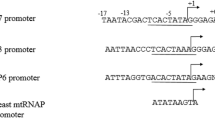Summary
The plasmid gene cat-86 specifies chloramphenicol-inducible, chloramphenicol acetyltransferase in Bacillus subtilis. The inducible regulation is independent of the promoter that is used to activate cat-86 and is independent of the cat-86 coding sequence. We have proposed that the regulation of cat-86 results from the transcription of a pair of inverted-repeat sequences that immediately precede the coding sequence. These transcripts are predicted to sequester the cat-86 ribosome binding site in a stable RNA stemloop which, in theory, should block the ribosome binding site from pairing with 16S rRNA. Inducible expression of cat-86 may therefore result in part from regulation of the translation of cat-86 mRNA. However, chloramphenicol-induction correlates with increased levels of cat-86 mRNA and the RNA stem-loop preceding the cat-86 coding sequence structurally resembles a rho-independent transcription terminator. We have therefore tested the inverted-repeats as a potential site of transcription termination. Transcription studies performed in vitro using SP6 RNA polymerase and in vivo by S1 mapping demonstrate that a substantial fraction of the potential cat-86 transcripts terminate at a site immediately 3′ to the inverted-repeats. The results of the in vivo experiments suggest that the termination signal may be partially relieved by growth of cells in chloramphenicol.
Similar content being viewed by others
References
Alton NK, Vapnek D (1979) Nucleotide sequence analysis of the chloramphenicol resistance transposon Tn9. Nature 282:864–866
Ambulos NP Jr, Chow JH, Mongkolsuk S, Preis L, Vollmar WR II, Lovett PS (1984) Constitutive variants of the pC194 cat gene exhibit DNA alterations in the vicinity of the ribosome-bindingsite sequence. Gene 28:171–176
Berk AJ, Sharp PA (1977) Sizing and mapping of early adenovirus mRNAs by gel electrophoresis of S1 endonuclease-digested hybrid. Cell 12:721–732
Butler EJ, Chamberlin M (1982) Bacteriophage SP6-specific RNA polymerase 1. Isolation and characterization of the enzyme. J Biol Chem 257:5772–5778
Byeon WH, Weisblum B (1984) Post-transcriptional regulation of chloramphenicol acetyltransferase. J Bacteriol 158:543–550
Duvall EJ, Mongkolsuk S, Kim UJ, Lovett PS, Henkin T, Chambliss GH (1985) Induction of the chloramphenicol actyltransferase gene cat-86 through the action of the ribosomal antibiotic amicetin. Involvement of a Bacillus subtilis ribosomal component in cat induction. J Bacteriol 161:665–672
Duvall EJ, Williams DM, Lovett PS, Rodolph C, Vasantha N, Guyer M (1983) Chloramphenicol inducible gene expression in Bacillus subtilis. Gene 24:170–177
Duvall EJ, Williams DM, Mongkolsuk S, Lovett PS (1984) Regulatory regions that control expression of two chloramphenicol-inducible cat genes cloned in Bacillus subtilis. J Bacteriol 158:784–790
Harwood CR, Williams DM, Lovett PS (1983) Nucleotide sequence of a Bacillus pumilus gene specifying chloramphenicol acetyltransferase. Gene 24:163–169
Horinouchi S, Weisblum B (1982) Nucleotide sequence and functional map of pC194, a plasmid that specifies inducible chloramphenicol resistance. J Bacteriol 150:815–825
Messing J, Crea R, Seeburg PH (1981) A system for shotgun DNA sequencing. Nucleic Acids Res 9:309–311
Mongkolsuk S, Ambulos NP Jr, Lovett PS (1984) Chloramphenicol inducible gene expression in Bacillus subtilis is independent of the chloramphenicol acetyltransferase structural gene and its promoter. J Bacteriol 160:1–8
Mongkolsuk S, Chiang YW, Reynolds RG, Lovett PS (1983) Restriction fragments that exert promoter activity during postexponential growth of Bacillus subtilis. J Bacteriol 155:1399–1406
Mongkolsuk S, Lovett PS (1984) Selective expression of a plasmid cat gene at a late stage of Bacillus subtilis sporulation. Proc Natl Acad Sci USA 81:3457–3460
Rosenberg M, Chepelinsky AB, McKenny K (1983) Studying promoters and terminators by gene fusion. Science 222:734–739
Shaw WV (1983) Chloramphenicol acetyltransferase: Enzymology and molecular biology. Crit Rev Biochem 14:1–43
von Hippel PH, Bear DG, Morgan WD, McSwiggen JA (1984) Protein-nucleic acid interactions in transcription: A molecular analysis. Ann Rev Biochem 53:389–446
Williams DM, Duvall EJ, Lovett PS (1981) Cloning restriction fragments that promote expression of a gene in Bacillus subtilis. J Bacteriol 46:1162–1165
Author information
Authors and Affiliations
Additional information
Communicated by E.K.F. Bautz
Rights and permissions
About this article
Cite this article
Ambulos, N.P., Mongkolsuk, S. & Lovett, P.S. A transciption termination signal immediately precedes the coding sequence for the chloramphenicol-inducible plasmid gene cat-86 . Molec Gen Genet 199, 70–75 (1985). https://doi.org/10.1007/BF00327512
Received:
Issue Date:
DOI: https://doi.org/10.1007/BF00327512




